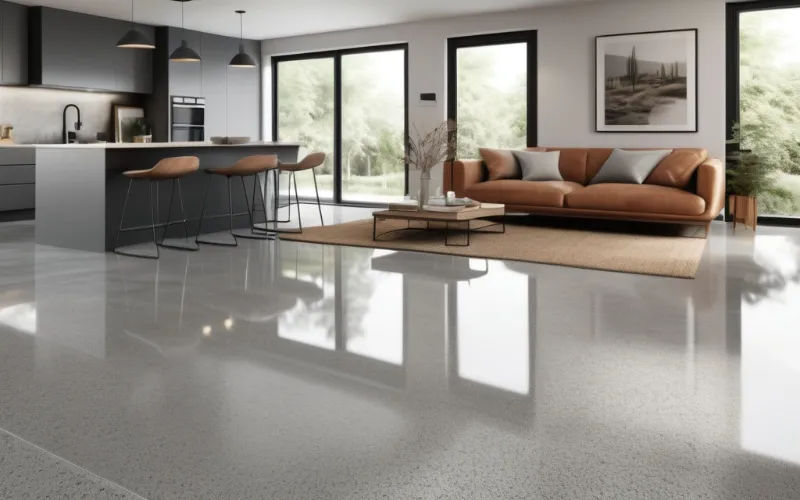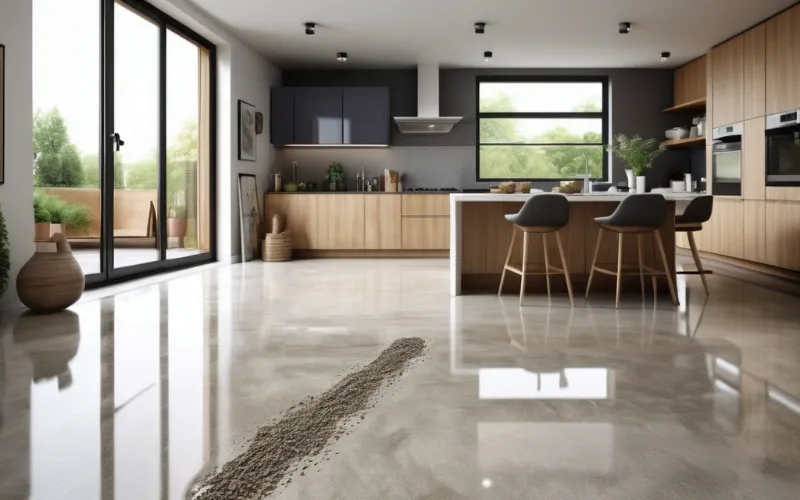The Foundation of Every Beautiful Screed In Homes.
Every detail matters when designing and constructing a home. One important aspect that is often overlooked is the screed in homes.
Not many people are aware of what screed is or its importance in homes. In simple terms, screed is a thin layer of cement-based material that acts as a base for flooring installations.
It’s usually applied over a concrete slab or underfloor heating. It levels the surface before laying floor finishes like tiles, carpets, or wood. However, not all screeds are the same; there are different types depending on their composition and application.
The Need for Screed in Homes
The importance of screed cannot be understated in any home construction or renovation project. Screed’s main job is to ensure a stable base for your floors. It must last for years, with no issues like cracks or moisture damage.
Leveling your subfloor with a screed before installing any flooring ensures a smooth, flat surface.
This maintains its strength. Without this vital process, irregularly shaped floors can become damaged over time. Unstable foundations, caused by weather changes, are to blame.
Temperature fluctuations and moisture can weaken them.
Also, using the right screed type helps with thermal insulation. It prevents heat loss through the ground into the atmosphere. It may also provide some sound insulation.
People often overlook screed in building projects or renovations. But, it has many benefits that outweigh its cost. This is true for both the short and long term.

What Are Screed In Homes?
First, let’s define screed. Screed is a mixture of sand, cement, and water that is applied to floors, walls, or ceilings as a leveling layer.
It can be poured onto a concrete or masonry surface. It will create a smooth, level base for various flooring materials.
It’s important to note that screed isn’t the final flooring material. Rather, it serves as an underlayment for other types of f, such asng like tiles, carpets, or wood.
Now that we know what screed is, let’s talk about the different types used in homes. There are three main types: traditional screed, self-leveling screed, and liquid screed.
Traditional screed is a cementitious mix. It can be mixed on-site or delivered premixed in bags.
This type of screed is typically used on projects with larger budgets because it requires more time and labor to install than other types.
Self-leveling screeds are made from anhydrite or calcium sulphate. They are mixed offsite and delivered in bags. They’re called self-leveling because they spread and level themselves quickly. They require little work from workers.
Liquid screeds are made with pumped liquids like anhydrite or calcium sulphate. They are combined with water and additives, such as polymers or fibers.
This type of screed has grown popular in recent years. It has many benefits over traditional and self-leveling options. It dries faster, allows for varied thicknesses, and costs less.
Purpose of Screed in Homes
Screed is vital in modern construction. It provides a level surface for installing floors. It is incorporated into most modern building projects as it offers various benefits to new homeowners. Let’s explore some of the purposes of screed in homes.
Leveling the floor surface
One of the key purposes of screed in homes is to provide a level surface that is optimal for installing flooring materials. Without screening, uneven surfaces may cause problems when laying floors.
This can lead to an unsightly finish and unsafe walking in your home.
Screed helps to solve this problem by providing a highly level base on which floors can be installed. This ensures the flooring you choose looks great and lasts.
It will have no maintenance issues from an uneven surface.
Providing a smooth finish for flooring installation
The screed makes a level base and a smooth finish. This helps with floor installation and improves your home’s look.
With many types of screeds, you can choose one that suits your needs. You can pick based on texture, thickness, and color.
Screeds’ smoothness makes cleaning easier. There are fewer places for dirt to hide. Plus, this additional layer adds an extra degree of protection against wear and tear over time.
Acts as a moisture barrier
Another important purpose of the screed is to block moisture. It acts as a barrier between the ground slab and the flooring above it.
Moisture can cause major structural damage over time if unchecked. It can lead to mold and, eventually, costly repairs. So, using quality screeding materials in construction helps.
It prevents water from penetrating beneath your home. This ensures its longevity and protection.
Enhances thermal insulation
Screed is an insulator and helps maintain a consistent temperature throughout your home. It’s vital in colder climates. Screed’s extra insulation can cut energy costs.
During installation, you can add more insulation. This will further improve efficiency. You’ll notice it as your heating bills drop.
Our discussion shows that screed is vital in modern construction. It benefits homeowners after they complete their new homes.
Screed provides a level surface for durable, great-looking floors, insulates, and reduces energy costs. It blocks moisture, preventing structural damage. This ensures peace of mind for years.
How is Screed In Homes Are Applied?
Preparation before application:
Before applying screed in homes, certain steps need to be taken to ensure proper bonding and adhesion. Firstly, surface cleaning is crucial as any dirt or debris can prevent proper bonding of the screed.
The surface should be cleaned with a vacuum cleaner or by sweeping away any debris. Additionally, moisture testing should be carried out to ensure that there is no dampness present on the surface.
If there are any signs of moisture present, they need to be addressed first before proceeding with screeding. After surface cleaning and moisture testing, the next step is to install a damp-proof membrane (DPM).
This membrane acts as a barrier against moisture, which could cause damage to the floor covering if left untreated. The DPM should be laid correctly and sealed at all joints and edges.
Application process:
Once preparation work has been completed, the application process can begin. To mix the screed materials, measure the correct amounts of water and cement mixtures for each batch.
It is important to mix these properly as it will affect how well the screed bonds with the substrate.
Carefully pour and spread the mixture. It must cover all areas evenly. Patches or holes will weaken it over time. A depth gauge may also be used during this stage, helping maintain even thickness throughout.
Screeds must be smoothed and leveled. Uneven surfaces can cause gaps or cracks in the flooring above. Applying screeds requires careful attention during preparation and application.
This includes surface cleaning and moisture testing. Then, mix the materials and pour them evenly across the surfaces. Don’t leave gaps or holes. Ensure the levels are even. After smoothing, the surface must be level.

Advantages and Disadvantages of Using Screeds in Homes
Advantages:
Screed is fundamental, particularly when it comes to giving a smooth and level base for the flooring material. Here are some of the advantages of using screeds in homes:
1) It makes flooring more durable and long-lasting. A key benefit of screed is that it provides a strong base for your flooring. This improves its durability and longevity, which means that you won’t have to replace or repair your floor frequently.
2) A level foundation reduces the risk of cracks and uneven surfaces. Low points can cause cracking, warping, or unevenness. With screed installation, this risk is greatly reduced since it provides a smooth surface for installation.
3) Enhanced thermal insulation: Screed is a great insulator. It’s made of cement and sand. As such, this helps keep your house warm during cold seasons and cool during hot weather.
Disadvantages:
While there are numerous benefits to using screeds in homes, there are also a few downsides.
1) Initial cost may be high. Hiring pros to install screed can be costly, depending on your choice of traditional or modern methods.
This can make a few homeowners bashfully absent from utilizing the service.
2) Cracking or shrinkage after application: In some cases, the screed may crack or shrink over time due to temperature changes, especially if not well installed. This may require reapplication.
Conclusion
Screeding your floor has many benefits. It makes your flooring more durable and long-lasting. Screed lowers the risk of cracks and uneven surfaces.
It also improves thermal insulation. There are some downsides to using screeds. They’re costly, and they may crack or shrink over time. But, the benefits far outweigh these drawbacks.
Screeding your floor is an investment. So, you must choose a reputable pro to do the work. This way, you can guarantee a long-lasting solution to your flooring needs.

